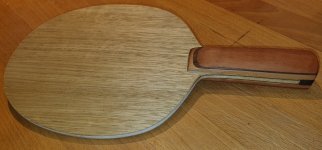That´s me.
Pitch is affected by the stiffness of the blade. Higher stiffness means higher pitch. Stiffness is dictated by many factors such as weight, composition, thickness, head size, etc... Out of these, weight is the most important when correlating pitch to speed. If the composition is the same, the one with higher pitch will be faster if the weight is the same. If the weight is not the same, the heavier one will produce lower pitch but will in fact be faster. That's because at higher speeds hardness is very important. So, there is a correlation between pitch and stiffness, but the correlation between stiffness and speed is not linear. The most evident cases are balsa and kiri core blades, that produce higher pitch than a different core blade counterpart, but will be much slower due to their lower weight (lower density->softer feel->lower speed at high impact), so they are usually paired with composites to get the best of both worlds (Lower weight, higher stiffness and hardness).
That being said, usually you can assume the speed of a blade based on the measured pitch with good confidence but direct comparisons have to be made with caution.











